
Oolong (, ; simplified Chinese: 乌龙茶; traditional Chinese: 烏龍茶 is a traditional semi-oxidized Chinese tea produced through a process that includes withering the leaves under strong sun and allowing some oxidation to occur before curling and twisting. Most oolong teas, especially those of fine quality, involve unique tea plant cultivars that are exclusively used for particular varieties. The degree of oxidation, which is controlled by the length of time between picking and final drying, can range from 8% to 85% depending on the variety and production style. Oolong is especially popular in southeastern China and among ethnic Chinese in Southeast Asia, as is the Fujian preparation process known as the gongfu tea ceremony.

Lapsang souchong or Zhengshan xiaozhong is a black tea consisting of Camellia sinensis leaves that may be smoke-dried over a pinewood fire. This smoking is accomplished either as a cold smoke of the raw leaves as they are processed or as a hot smoke of previously processed leaves. The intensity of the smoke aroma can be varied by locating the leaves closer or farther from the source of heat and smoke or by adjusting the duration of the process. The flavour and aroma of smoked lapsang souchong is described as containing empyreumatic notes, including wood smoke, pine resin, smoked paprika, and dried longan; it may be mixed with milk but is not bitter and usually not sweetened with sugar. The tea originates from the Wuyi Mountains region of Fujian and is considered a Wuyi tea. It is also produced in Taiwan. It has been labelled as smoked tea, smoky souchong, tarry lapsang souchong and lapsang souchong crocodile. While the tea leaf grading system adopted the term souchong to refer to a particular leaf position, lapsang souchong may be made with any leaf of the Camellia sinensis plant, though it is not unusual for the lower leaves, which are larger and less flavourful, to be used as the smoking compensates for the lower flavour profile and the higher leaves are more valuable for use in unflavoured or unblended teas. In addition to its consumption as a tea, lapsang souchong is also used in stock for soups, stews and sauces or otherwise as a spice or seasoning. Beginning in the early 21st century, an unsmoked variety of lapsang souchong was developed in the village of Tong Mu Guan in the Wuyi mountains. The unsmoked variety has become increasingly popular, particularly in the Chinese domestic market.

The Wuyi Mountains or Wuyishan are a mountain range located in the prefecture of Nanping, in northern Fujian province near the border with Jiangxi province, China. The highest peak in the area is Mount Huanggang at 2,158 metres (7,080 ft) on the border of Fujian and Jiangxi, making it the highest point of both provinces; the lowest altitudes are around 200 metres (660 ft). Many oolong and black teas are produced in the Wuyi Mountains, including Da Hong Pao and lapsang souchong, and are sold as Wuyi tea. The mountain range is known worldwide for its status as a refugium for several rare and endemic plant species, its dramatic river valleys, and the abundance of important temples and archeological sites in the region, and is a UNESCO World Heritage Site.

Rougui tea is a variety of the tea plant, commonly grown in the Wuyi Mountains and processed into oolong tea. The name literally means "cassia". The tea can be difficult to prepare, but its distinctive sweet aroma can be brought out up to 7 steepings. It was first developed during the Qing dynasty.

Shui Xian is a cultivar of Camellia sinensis as well as an oolong tea traditionally from the Wuyi Mountains in Fujian, China. The infused color is a deep amber which is characteristic for many other Wuyi oolong teas. This tea is also grown in Taiwan.

Huang Meigui is a relatively new Wuyi oolong tea, developed c. 2002. It has a highly aromatic fragrance and a lighter floral taste than most other Wuyi oolongs.

Jin Fo tea is a Wuyi Oolong tea, developed at the Wuyi Shan Tea Researching Center located in Fujian Province, China. It is a medium Wuyi Oolong showing both creaminess and a floral aftertaste. The tea leaves have a uniform emerald green colour.
Si Da Ming Cong is a collective term referring to four famous Wuyi oolong tea bush varieties and the tea beverages made from them, namely:

Tieluohan or Tie Luo Han is one of the Four Great Oolongs and a light Wuyi tea. Tieluohan is the cultivar responsible for one of the four best known Yán chá, "rock teas" grown on cliffs in the Wuyi Mountains in northern Fujian Province, China. Legend tells that this tea was created by a powerful warrior monk with golden-bronze skin, hence the name Tieluohan, which means "Iron Arhat" or "Iron Warrior Monk".

Bai Ji Guan or Bai Jiguan is a very light Si Da Ming Cong tea, a well-known oolong tea of Wuyi, in Fujian, China.
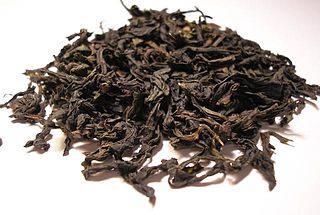
Wuyi tea, also known by the trade name Bohea in English, is a category of black and oolong teas grown in the Wuyi Mountains of northern Fujian, China. The Wuyi region produces a number of well-known teas, including Lapsang souchong and Da Hong Pao. It has historically been one of the major centers of tea production in Fujian province and globally. Both black tea and oolong tea were likely invented in the Wuyi region, which continues to produce both styles today.
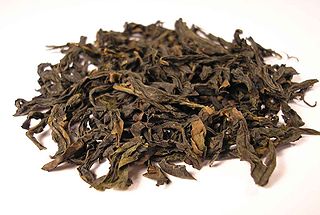
Qilan is a very mild Wuyi oolong tea. It has an obvious sweet and nutty aroma.

Jin Suo Chi is a very rare Wuyi Oolong with a light taste.
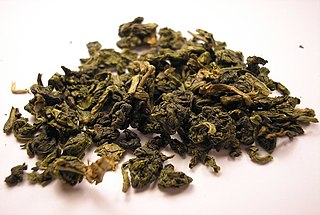
Huang Guanyin tea is a Wuyi oolong with a creamy taste. It can be either tightly rolled like Anxi Oolongs or in strips like conventional Wuyi Oolong.

Huangjin Gui is a premium variety of Chinese oolong tea traditionally from Anxi in Fujian province. Named after the yellow golden color of its budding leaves and its unique flowery aroma, it is said to be reminiscent of Osmanthus.
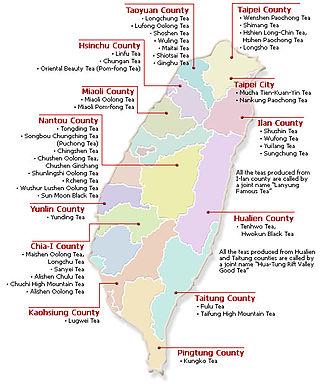
Taiwanese tea includes four main types: oolong tea, black tea, green tea and white tea. The earliest record of tea trees found in Taiwan is from 1717 in Shui Sha Lian (水沙連), present-day Yuchi and Puli, Nantou County. Some of the teas retain the island country's former name, Formosa.
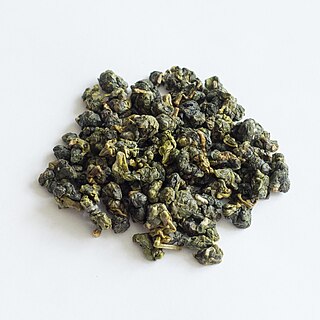
Jin Xuan is a variety of oolong tea developed in 1980. The tea is also known as #12 or as "Milk Oolong". It originates from Taiwan. The taste is light, creamy, and flowery and sometimes compared to milk. This tea variety can be grown at higher altitudes, and the yield is about 20% higher compared to traditional tea varieties. These circumstances made it one of the most popular varieties among tea farmers in Taiwan and Thailand. While genuine Jin Xuan naturally tastes milky, some producers produce artificial Jin Xuan through additives.

Jinjunmei (金駿眉) is a celebrated black tea from the Wuyi Mountains in Fujian Province, China. It is made exclusively from the buds plucked in early spring from the tea plant. The buds are subsequently fully oxidized and then roasted to yield a tea that has a sweet, fruity and flowery flavour with a long-lasting sweet after-taste. The brew is bright reddish in colour. It is a representative of high-end black tea in Fujian and has now become one of the most expensive varieties of black tea in China.

Dong Ding, also spelled Tung-ting, is an oolong tea from Taiwan. A translation of Dong Ding is "Frozen Summit" or "Icy Peak", and is the name of the mountain in Taiwan where the tea is cultivated. Those plants were brought to Taiwan from the Wuyi Mountains in China's Fujian Province about 150 years ago.




















